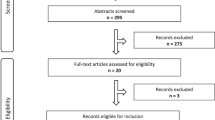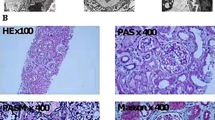Abstract
Reproductive genetic carrier screening (RGCS) is expanding in both public and private healthcare. The primary aim is to identify carrier status for genetic disorders, inform reproductive decision making and promote reproductive autonomy. As screening panels have increased, the potential for findings with personal health implications rises. We report the prevalence of COL4A3/COL4A4 heterozygous variants within a population undergoing RGCS in a private setting and propose a comprehensive management plan for the ongoing care of this patient cohort. Acknowledging that comprehensive guidelines exist for genetic testing and management of Alport syndrome as a broad patient group, this communication seeks to highlight the increasingly common finding of autosomal dominant Alport syndrome and proposes accessible and practical strategies for the clinicians encountering these patients.
This is a preview of subscription content, access via your institution
Access options
Subscribe to this journal
Receive 12 print issues and online access
$259.00 per year
only $21.58 per issue
Buy this article
- Purchase on SpringerLink
- Instant access to full article PDF
Prices may be subject to local taxes which are calculated during checkout
Similar content being viewed by others
References
Kirk EP, Ong R, Boggs K, Hardy T, Righetti S, Kamien B, et al. Gene selection for the Australian Reproductive Genetic Carrier Screening Project (‘Mackenzie’s Mission’). Eur J Hum Genet. 2021;29:79–87.
Archibald A, McClaren B, Caruana J, Tutty E, King E, Halliday J, et al. The Australian Reproductive Genetic Carrier Screening Project (Mackenzie’s Mission): Design and implementation. J Pers Med. 2022 Oct 28;12. Available from: https://www.mdpi.com/2075-4426/12/11/1781.
Department of Health. Medicare Benefits Schedule 73451 [Internet]. Australian Government - Department of Health and Aged Care. 2023 [cited 2024 Jul 8]. Available from: https;//www9.health.gov.au/mbs/fullDisplay.cfm?type=item&q=73451qt=item&criteria=73451.
Archibald AD, Smith MJ, Burgess T, Scarff KL, Elliott J, Hunt CE, et al. Reproductive genetic carrier screening for cystic fibrosis, fragile X syndrome, and spinal muscular atrophy in Australia: outcomes of 12,000 tests. Genet Med. 2018;20:513–23.
Gbur S, Mauney L, Gray KJ, Wilkins-Haug L, Guseh S. Counseling for personal health implications identified during reproductive genetic carrier screening. Prenat Diagn. 2021;41:1460–6.
Chora JR, Iacocca MA, Tichý L, Wand H, Kurtz CL, Zimmermann H, et al. The Clinical Genome Resource (ClinGen) Familial Hypercholesterolemia Variant Curation Expert Panel consensus guidelines for LDLR variant classification. Genet Med. 2022;24:293–306.
Kashtan CE. Alport Syndrome: Achieving Early Diagnosis and Treatment. Am J Kidney Dis. 2021;77:272–9.
Savige J. Should We Diagnose Autosomal Dominant Alport Syndrome When There Is a Pathogenic Heterozygous COL4A3 or COL4A4 Variant? Kidney Int Rep. 2018;3:1239–41.
Matthaiou A, Poulli T, Deltas C. Prevalence of clinical, pathological and molecular features of glomerular basement membrane nephropathy caused by COL4A3 or COL4A4 mutations: a systematic review. Clin Kidney J. 2020;13:1025–36.
Furlano M, Martínez V, Pybus M, Arce Y, Crespí J, Venegas MDP, et al. Clinical and Genetic Features of Autosomal Dominant Alport Syndrome: A Cohort Study. Am J Kidney Dis. 2021;78:560–570.e1.
Rocco B, Grasso AAC, Ferraresso M, Messa PG. Re: Kidney-Failure Risk Projection for the Living Kidney-Donor Candidate. Eur Urol. 2016;70:401.
Savige J, Huang M, Croos Dabrera MS, Shukla K, Gibson J. Genotype-Phenotype Correlations for Pathogenic COL4A3–COL4A5 Variants in X-Linked, Autosomal Recessive, and Autosomal Dominant Alport Syndrome. Front Med. 2022;9. Available from: https://www.frontiersin.org/journals/medicine/articles/10.3389/fmed.2022.865034.
Jais JP, Knebelmann B, Giatras I, De Marchi M, Rizzoni G, Renieri A, et al. X-Linked Alport Syndrome: Natural History and Genotype-Phenotype Correlations in Girls and Women Belonging to 195 Families: A “European Community Alport Syndrome Concerted Action” Study. J Am Soc Nephrol. 2003;14:2603.
Levy M, Feingold J. Estimating prevalence in single-gene kidney diseases progressing to renal failure. Kidney Int. 2000;58:925–43.
Gibson J, Fieldhouse R, Chan MMY, Sadeghi-Alavijeh O, Burnett L, Izzi V, et al. Prevalence Estimates of Predicted Pathogenic COL4A3-COL4A5 Variants in a Population Sequencing Database and Their Implications for Alport Syndrome. J Am Soc Nephrol. 2021;32:2273–90.
Gregorio VD, Caparali EB, Shojaei A, Ricardo S, Barua M. Alport Syndrome: Clinical Spectrum and Therapeutic Advances. Kidney Med. 2023;5:100631.
Kashtan CE, Gross O. Clinical practice recommendations for the diagnosis and management of Alport syndrome in children, adolescents, and young adults-an update for 2020. Pediatr Nephrol. 2021;36:711–9.
Savige J, Lipska-Zietkiewicz BS, Watson E, Hertz JM, Deltas C, Mari F, et al. Guidelines for Genetic Testing and Management of Alport Syndrome. Clin J Am Soc Nephrol. 2022;17:143–54.
Muntner P, Shimbo D, Carey RM, Charleston JB, Gaillard T, Misra S, et al. Measurement of Blood Pressure in Humans: A Scientific Statement From the American Heart Association. Hypertension. 2019;73:e35–66.
Imafuku A, Nozu K, Sawa N, Nakanishi K, Ubara Y. How to resolve confusion in the clinical setting for the diagnosis of heterozygous COL4A3 or COL4A4 gene variants? Discussion and suggestions from nephrologists. Clin Exp Nephrol. 2020;24:651–6.
Funding
There is no funding to declare.
Author information
Authors and Affiliations
Contributions
GB, DA and CQ conceived the idea for the paper. GB wrote the initial draft. All authors contributed to the manuscript, revised the manuscript and approved the final version.
Corresponding author
Ethics declarations
Competing interests
The authors declare no competing interests.
Additional information
Publisher’s note Springer Nature remains neutral with regard to jurisdictional claims in published maps and institutional affiliations.
Rights and permissions
Springer Nature or its licensor (e.g. a society or other partner) holds exclusive rights to this article under a publishing agreement with the author(s) or other rightsholder(s); author self-archiving of the accepted manuscript version of this article is solely governed by the terms of such publishing agreement and applicable law.
About this article
Cite this article
Butler, G., Amor, D.J. & Quinlan, C. From screening to strategy: Clinical implications of COL4A3/COL4A4 variants found in reproductive genetic testing. Eur J Hum Genet (2025). https://doi.org/10.1038/s41431-025-01953-3
Received:
Revised:
Accepted:
Published:
DOI: https://doi.org/10.1038/s41431-025-01953-3



